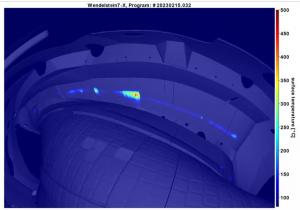Wendelstein 7-X surpasses target
Early in its new campaign, the Wendelstein 7-X stellarator has reached (and passed) a target, achieving an energy turnover of 1.3 gigajoules. What's more, the hot plasma was maintained for eight minutes.
Equipped over a three-year shutdown phase with water cooling for the wall elements and an upgraded heating system, and re-commissioned in autumn 2022, the Wendelstein 7-X stellarator at the Max Planck Institute for Plasma Physics (IPP) in Greifswald, Germany, was ready to explore new parameter ranges.
The first goal—an energy turnover of 1 gigajoule—was surpassed on 15 February 2023 when the researchers achieved 1.3 gigajoules in the machine during a plasma discharge that lasted eight minutes. This is notable for a stellarator-type device and represents a record at Wendelstein 7-X; before the upgrade, the machine had achieved maximum plasma times of 100 seconds at much lower heating power.
"We are now exploring our way towards ever higher energy values," says Thomas Klinger, head of the Stellarator Transport and Dynamics Division. "In doing so, we have to proceed step by step so as not to overload and damage the facility."
The goal within a few years is to increase the energy turnover at Wendelstein 7-X to 18 gigajoules, with the plasma stable for 30 minutes.
See the original press release on the IPP website.
Watch a video about the importance of the milestone here.


